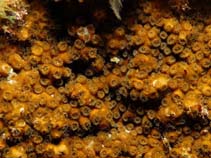Oculina patagonica Angelis, 1908
| Native range | All suitable habitat | Point map | Year 2050 |

|
| This map was computer-generated and has not yet been reviewed. |
| Oculina patagonica AquaMaps Data sources: GBIF OBIS |
Classification / Names Common names | Synonyms | CoL | ITIS | WoRMS
Hexacorallia | Scleractinia | Oculinidae
Environment: milieu / climate zone / depth range / distribution range Ecology
Sessile; depth range 0 - 40 m (Ref. 847). Subtropical; 46°N - 30°N, 5°W - 37°E (Ref. 847)
Distribution Countries | FAO areas | Ecosystems | Occurrences | Introductions
Atlantic and the Mediterranean Sea.
Length at first maturity / Size / Weight / Age
Maturity: Lm ? range ? - ? cm
Short description Morphology
This species is both zooxanthellate and azooxanthellate with colonies encrusting and forms clumps of short, thick, highly fused branches. Corallites are crowded and have neat round exsert walls. Usually yellowish-brown in color.
Life cycle and mating behavior Maturity | Reproduction | Spawning | Eggs | Fecundity | Larvae
Members of the class Anthozoa are either gonochoric or hermaphroditic. Mature gametes are shed into the coelenteron and spawned through the mouth. Life cycle: The zygote develops into a planktonic planula larva. Metamorphosis begins with early morphogenesis of tentacles, septa and pharynx before larval settlement on the aboral end.
Main reference
References | Coordinator | Collaborators
Veron, J.E.N. 2000. (Ref. 847)
IUCN Red List Status (Ref. 130435: Version 2024-1)
Least Concern (LC) ; Date assessed: 22 February 2022
CITES status (Ref. 108899)
Appendix II: International trade monitored
CMS (Ref. 116361)
Not Evaluated
Threat to humans
Human uses
| FishSource |
Tools
More information
Trophic Ecology
Food items
Diet
Food consumption
Ration
Predators
Diet
Food consumption
Ration
Predators
Ecology
Population dynamics
Growth
Age/Size
Length-weight
Length-length
Length-frequencies
Mass conversion
Recruitment
Abundance
Age/Size
Length-weight
Length-length
Length-frequencies
Mass conversion
Recruitment
Abundance
Life cycle
Distribution
Human Related
Aquaculture profile
Stamps, Coins Misc.
Stamps, Coins Misc.
Outreach
Taxonomy
References
Internet sources
BHL | BOLD Systems | CISTI | DiscoverLife | FAO(Publication : search) | Fishipedia | GenBank (genome, nucleotide) | GloBI | Gomexsi | Google Books | Google Scholar | Google | PubMed | Tree of Life | Wikipedia (Go, Search) | Zoological Record
Estimates based on models
Preferred temperature
(Ref. 115969): 16.5 - 21.5, mean 19 (based on 94 cells).
Price category
(Ref. 80766):
Unknown.



